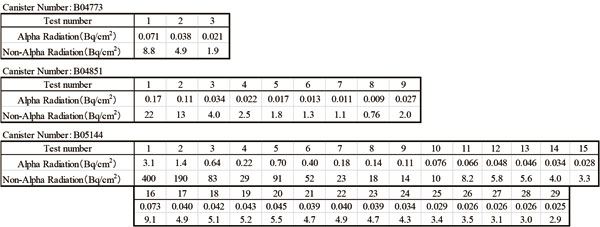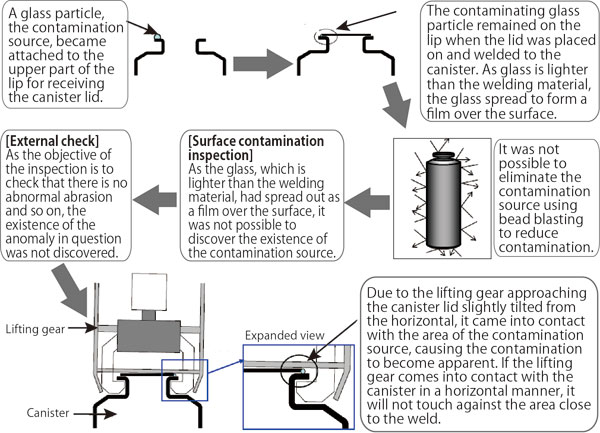This accident is serious. The inspection jointly conducted by JNFL, Kyushu Electric Power Co. (KEPCO) and Nuclear Fuel Transport Co. in Britain prior to the shipment of the vitrified HLW revealed no radioactive contamination on the surface of the canisters. If the contamination emerged during the transportation period, only a matter of several weeks, this means that there must be a serious problem with the integrity of the canisters. Possible causes of this flaw are defective welding on the canister and damage to the surface of the canisters. Unless full-fledged investigations into the cause of this problem are carried out, including the re-examination of the whole process of HLW vitrification, and sufficient measures taken to prevent a recurrence of the problem, the transport of vitrified HLW must be halted. This is a follow-up report on the radioactive contamination on the surface of the vitrified HLW canisters returned from Britain to Japan on Sept. 15, 2011. The canister (B05144), whose surface was found to be contaminated with an extremely high level (400 Bq/cm2) of non-alpha radiation, 100 times higher than the reference level, was wiped several tens of times and was said to have cleared the reference level. On Dec. 26, the canister was stored in the storage pit at the high-level radioactive waste storage control center in the Rokkasho Reprocessing Plant in Aomori Prefecture. Three months later, on March 23, 2012, JNFL and KEPCO, the owner of the vitrified HLW, jointly announced the suspected cause of the contamination of the canister surfaces and measures to prevent a recurrence of the problem. As to the cause, they claimed that in the production process, fine glass powder containing radioactive substances became attached to the surface of the canister where the lid fits onto the body of the canister. The worker, however, welded the lid on without removing the glass powder stuck on the surface of the canister, and as a result of this, the glass powder melted and formed a thin film of glass on part of the surface. The vitrified HLW was then shipped to Japan. According to the two companies, in the JNFL inspection conducted prior to the storage of the glass blocks, the crane that lifted the glass blocks came into contact with the contaminated surface, crushing the glass film into small pieces, thereby exposing the contamination. Thus far, no detailed data on this incident have been disclosed, and no explanation has been given for the details of the contaminated canister surfaces, the vitrification process in Britain, or why (or how) the lid was the cause of the contamination. Referring to preventive measures, it has been suggested that there will be more frequent visual inspections using cameras in Britain. Should radioactive contamination be discovered on the canister surface during physical inspections, additional bead blasting, a process for removing surface deposits by spraying fine stainless-steel beads at a high pressure, will be carried out. However, the fact remains that beat blasting was conducted in Britain after the vitrified HLW was loaded into the canisters, and inspections did not detect contamination on the canister surface. Under the current circumstances, the only measure that can be taken when contamination is discovered in the pre-storage inspection is to apply more bead blasting to the surface of the vitrified HLW canisters produced in Sellafield. Bead blasting, however, has a number of shortcomings, for example, that it will create more nuclear waste, and that it will aggravate the contamination of the canister surface if the beads themselves become contaminated. As things stand now, JNFL is considering the quite natural response of refusing to accept the return of the vitrified HLW to Japan if it is impossible to decontaminate the canisters. (Masako Sawai, CNIC)
Return to NIT 148 contents See CNIC's Radioactive Waste page |

| CNIC Citizens' Nuclear Information Center Akebonobashi Co-op 2F-B, 8-5 Sumiyoshi-cho, Shinjuku-ku, Tokyo, 162-0065, Japan TEL.03-3357-3800 FAX.03-3357-3801 Map http://cnic.jp/english/ |


